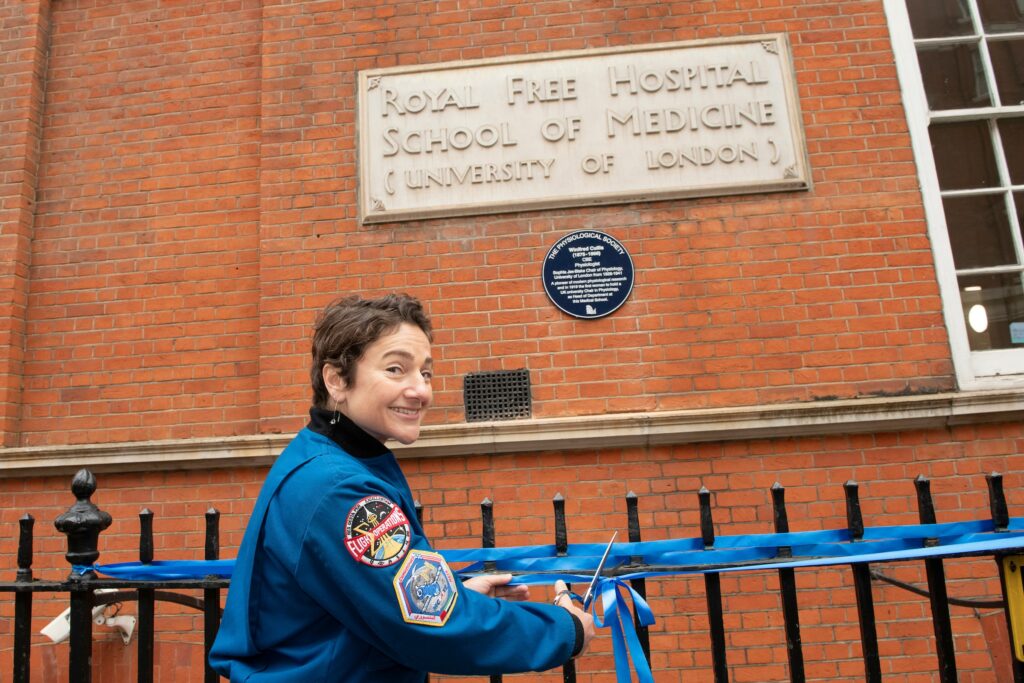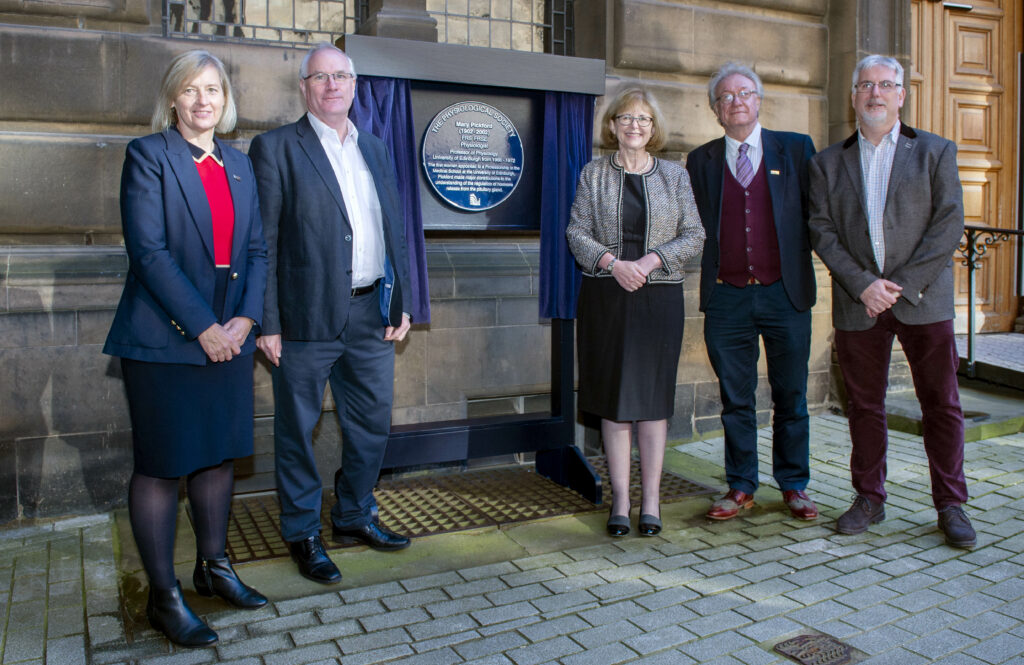
Physiology News Magazine
President’s View
Nobel Prizes, blue plaques, and interdisciplinary research
News and Views
President’s View
Nobel Prizes, blue plaques, and interdisciplinary research
News and Views
https://doi.org/10.36866/pn.124.6
Professor David Paterson, President, The Physiological Society
In October I was delighted to congratulate Professor David Julius and Professor Ardem Patapoutian on behalf of The Physiological Society for their Nobel Prize in Physiology or Medicine. Their discoveries of receptors for temperature and touch is a great example of the ground-breaking work of physiologists. How we sense temperature, touch and movement are some of the great questions for humanity, and this research sheds light on how we sense and interact with the environment around us. It will be vital to develop treatments for chronic pain and other disease conditions and is a showcase for the vital contribution physiology makes to our lives.
As well as congratulating this year’s Nobel Prize winners, I have been pleased to celebrate Nobel Prize winners of the past over the last few weeks, as we continue to erect Society blue plaques across the country (1). In September we unveiled blue plaques for Archibald Vivian Hill (known as AV Hill) in Manchester and Sir Charles Scott Sherrington in Liverpool. The blue plaques honour outstanding physiologists who have contributed to the advancement of the discipline through their discoveries while leaving a legacy beyond their lifetime, while celebrating and recognising institutions where distinguished physiologists have made significant contributions to the discipline alongside raising the visibility of physiology and giving the wider public an insight into the positive role that ‘the science of life’ plays in their everyday lives.
AV Hill was one of the founders of the disciplines of biophysics and operations research. He was the Brackenbury Professor of Physiology at Manchester University from 1920 to 1923, and was awarded the Nobel Prize in 1922, aged just 36, for his studies on the production of heat and mechanical work in muscles. It was particularly special to unveil the blue plaque on the University of Manchester’s Coupland Building 3, which was the old medical school at Victoria University of Manchester, where AV Hill worked. A life- long humanitarian, Hill worked with Ernest Rutherford and William Beveridge to establish the Academic Assistance Council, which helped scientist victims of Nazi persecution at a time when the events in Germany were not known to many people in the UK. This organisation helped a thousand scientists escape, including 18 who went on to win Nobel Prizes.
At the University of Liverpool, I was delighted to recognise the tremendous achievements of Sir Charles Sherrington by unveiling a blue plaque to him on the University of Liverpool’s Sherrington Building. Sherrington was awarded the Nobel Prize in 1932 with Edgar Adrian for their work on the functions of neurons. Prior to their research, it was thought that reflexes occurred as isolated activity within a reflex arc; they showed that instead, reflexes require integrated activation and showed reciprocal innervation of muscles, a principle now called Sherrington’s Law. In Edinburgh, we unveiled a blue plaque for Professor Mary Pickford, who started her career when there were few women doctors and considerable prejudice against women scientists. She went on to make her mark on medicine and physiological science.
Alongside the unveiling of our blue plaques, we have held Member Roadshows for members to meet Trustees and their local Society Representative. Following 18 months of COVID-19 and lockdowns, I have really enjoyed getting out around the country speaking to members face to face. We have many more roadshows planned over the next few months and I hope to meet many more members.
In November we have two prominent Society events taking place. We are holding an event in Parliament to launch our new report called The Future of Interdisciplinary Research Beyond REF2021. Physiology, by its nature, is a quintessential interdisciplinary science. From the immediate crisis of COVID-19 to long- term challenges such as our ageing society and climate change, the major issues facing the world require an interdisciplinary approach to solve.

Therefore, our project sought to consider how the UK’s research system can better recognise and foster interdisciplinary research. We commissioned Research Consulting to carry out 1-1 interviews and focus groups
with a range of experts across the sector. We have brought together a Steering Group, chaired by Professor David Eisner, comprising representatives from across the research landscape, including The Royal Society, Royal Society of Chemistry, Institute of Physics, Campaign for Science and Engineering, Royal Society of Biology, Russell Group and GuildHE. The report makes recommendations on how we can increase the quantity of interdisciplinary research and address current barriers within the research ecosystem. You can read more about the report on page 10 and access the full report on our website (2).
In November we also have our 2021 Member Forum and President’s Lecture. The President’s Lecture is the most prestigious event of The Society’s calendar, and this year will be delivered by Dr Jessica Meir. Meir is a NASA astronaut and physiologist and, prior to becoming an astronaut, her career as a scientist focused on the physiology of animals in extreme environments. In 2019, while on the International Space Station, Jessica took part in NASA’s first all-female spacewalk.
Finally, I am delighted to congratulate our 2021 Honorary Fellows, who will officially be appointed at our President’s Lecture:
- Professor Dame Kay Davies CBE DBE FMedSci FRS, University of Oxford, UK
- Professor Maria Fitzgerald FMedSci FRS, University College London, UK
- Professor Christine Holt FRSB FMedSci FRS, University of Cambridge, UK
- Professor Carla J. Shatz PhD ForMemRS, Stanford University, California, US
- Professor Fiona Watt FRS FMedSci, King’s College London, UK
- Professor Melanie Welham FRSB, Biotechnology and Biological Sciences Research Council (BBSRC)
- Rt Hon. Lord David Willetts FRS, Resolution Foundation

I am particularly pleased that, given The Society’s focus on improving diversity and inclusion in science, that so many of our Honorary Members this year are women.
From congratulating this year’s Nobel Prize winners, celebrating distinguished physiologists of the past, or ensuring the voices of our members are heard in the corridors of power, The Society’s activities continue to go from strength to strength. I do hope you see you at one of our upcoming Member Roadshows or events around the country.
References
1. The Physiological Society (2021). The Physiological Society’s blue plaques. Available at: https://www. physoc.org/about-us/our-blue-plaques/
2. The Physiological Society (2021). The Future of Interdisciplinary Research Beyond REF 2021. Available at: https://www.physoc.org/interdisciplinary
